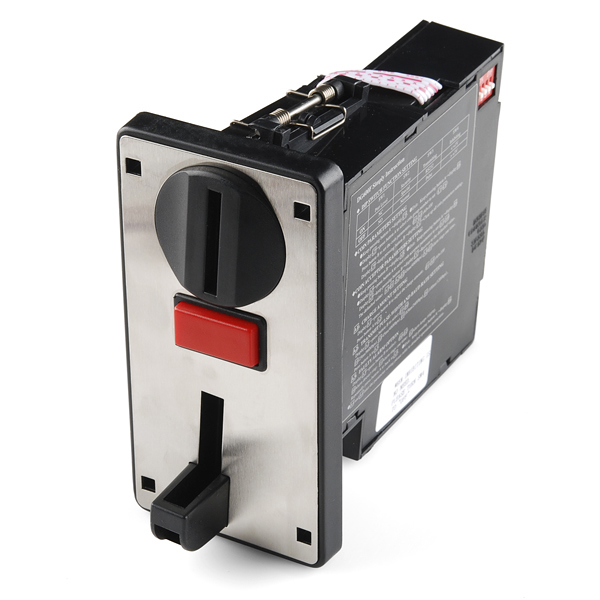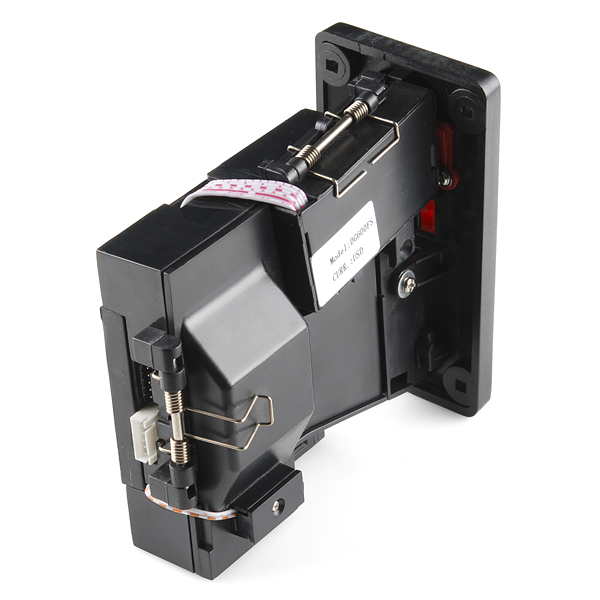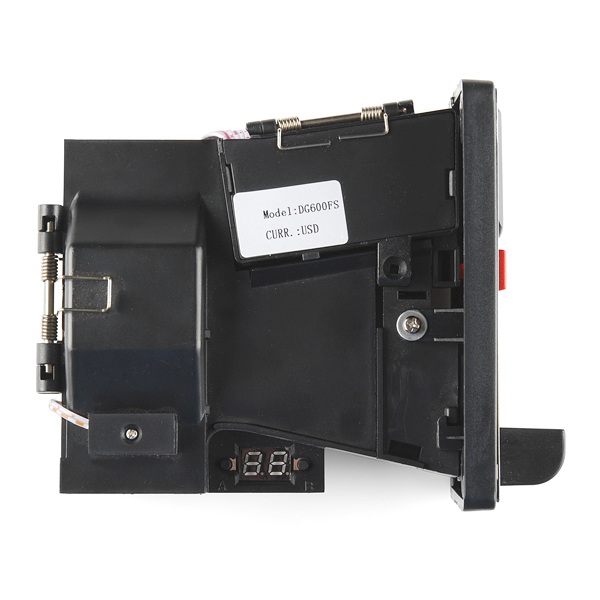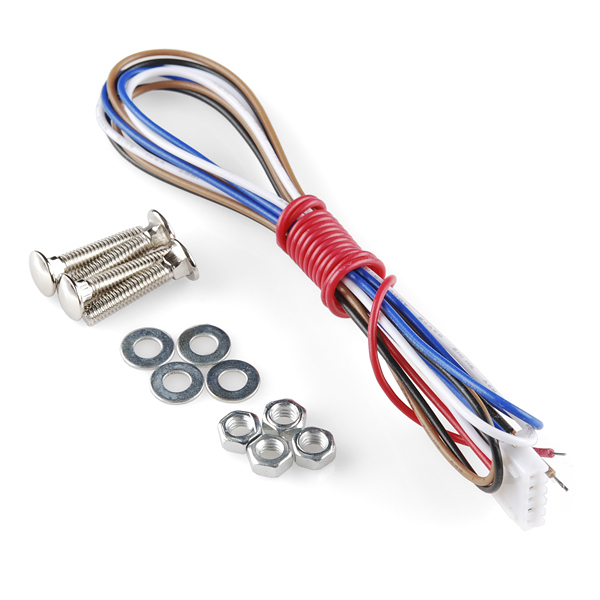Coin Acceptor - Programmable (6 coin types)
Are you trying to make a quick dime from electronics? Why limit yourself to dimes? This coin acceptor will take up to 6 different kinds of coin! Whether you're building your own arcade cabinet or just charging admission to your house, this programmable coin acceptor makes it easy to monetize your next project.
The sensors in this coin acceptor use the thickness, diameter and fall time of the coins to identify them and it's fully programmable so you're not limited to any particular type of currency. Simply use the buttons and 7-segment display on the side of the unit to select a coin profile, insert a bunch of coin samples (or the same one, over and over) then designate the value. After you've programmed the coin profiles, simply read the serial output of the coin acceptor and it will tell you the value of each coin as they're inserted. It reports these values as binary bytes and the baud rate is selectable on the unit.
This coin acceptor also has a coin reject, so your controller can tell the coin acceptor not to take any more coins, as well as a (very loud) alert beeper. All you need to get the coin acceptor working is a pocket full of change, a 12VDC supply and somewhere for the change to fall after it's accepted.
So maybe you won't get rich building your own vending machines but access control using different sizes of tokens might be cool, or even a virtual vending machine where you can buy MMORPG items. There are a ton of cool coin-operated projects just *waiting *to be built!
- Recognizes 6 Programmable Groups of Coins in Different Denominations
- Accepts coins from 17-30.5mm in Diameter and 1.25-3.2mm in Thickness
- Serial or Pulse-Width Output with Selectable Speed/Baud Rate
- Can be Set to Stop Accepting All Coins
- Industrial Standard 10Pin Parallel Port Connector
- Simple 0.1" Spaced 5-Pin Serial Port Header
- Draws 50mA @ 12VDC Standby, 450mA At Instant of Collection
- Able to release coins in jam
Coin Acceptor - Programmable (6 coin types) Product Help and Resources
Arduino Example Code
Example code and tutorial for the DG600F coin acceptor using Arduino and a Raspberry Pi :
If you are using the coin acceptor's interrupt outputs, try checking out our tutorial on processor interrupts with Arduino to get an idea of how to use hardware interrupts.
Tips on Viewing the Coin Acceptor's Serial Output
The demo video did not use Arduino code. Nick just connected a USB-to-serial converter to a 6-coin acceptor (calibrated with different samples for the coin denominations). By opening a serial terminal connected to the COM port (with the setting 9600 baud, 8-none-1-none), Nick was able to view the output when a coin was recognized.
If you are using a 5V Arduino microcontroller, you could check if there was serial data sent from the 6-coin acceptor's UART with a serial passthrough sketch => [ https://learn.sparkfun.com/tutorials/xbee-shield-hookup-guide#example-communication-test ]. The code was designed to pass serial data from an XBee (connected to the software serial pins) to the serial monitor. Just make sure to connect Tx to Rx and vice versa. For reference you would need to connect the ground pin for reference. Here is a summary of the connections:
6 Coin Acceptor <=> 12 Power Supply <=> 5V FTDI
12v <=> +12V <=> -(NC)-
Serial Output <=> -(NC)- <=> RXI
0V <=> GND <=> GND
Counter Output <=> -(NC)- <=> -(NC)-
Inhibiting Port <=> -(NC)- <=> -(NC)-
Note: -(NC)- means that there is nothing connected.
For more information on serial UARTs, I recommend looking at this tutorial => https://learn.sparkfun.com/tutorials/serial-communication#uarts . I also recommend looking at the Arduino Serial Library [ https://www.arduino.cc/en/Reference/Serial ].
UART Logic Level
Looking at the datasheet, the serial signal output (Rx) and the counter output is 5V. If you are using this with a 3.3V system (Raspberry Pi or BBB), a logic level converter or resistors for voltage division is required.
Core Skill: DIY
Whether it's for assembling a kit, hacking an enclosure, or creating your own parts; the DIY skill is all about knowing how to use tools and the techniques associated with them.
Skill Level: Noob - Basic assembly is required. You may need to provide your own basic tools like a screwdriver, hammer or scissors. Power tools or custom parts are not required. Instructions will be included and easy to follow. Sewing may be required, but only with included patterns.
See all skill levels
Core Skill: Programming
If a board needs code or communicates somehow, you're going to need to know how to program or interface with it. The programming skill is all about communication and code.
Skill Level: Rookie - You will need a better fundamental understand of what code is, and how it works. You will be using beginner-level software and development tools like Arduino. You will be dealing directly with code, but numerous examples and libraries are available. Sensors or shields will communicate with serial or TTL.
See all skill levels
Core Skill: Electrical Prototyping
If it requires power, you need to know how much, what all the pins do, and how to hook it up. You may need to reference datasheets, schematics, and know the ins and outs of electronics.
Skill Level: Competent - You will be required to reference a datasheet or schematic to know how to use a component. Your knowledge of a datasheet will only require basic features like power requirements, pinouts, or communications type. Also, you may need a power supply that?s greater than 12V or more than 1A worth of current.
See all skill levels
Comments
Looking for answers to technical questions?
We welcome your comments and suggestions below. However, if you are looking for solutions to technical questions please see our Technical Assistance page.
Customer Reviews
3.8 out of 5
Based on 5 ratings:
This thing is great! two of those babies were installed in my arcade machine
I bought 2 coin acceptors. They do everything I wanted and they look great. I connected both of mine to an Arduino Micro and that is connected to my arcade machine PC.
one of the units had a malfunction. immediately after contacting sparkfun, they helped me with it. one of the best customer services I ever got!
Good Quality, Easy Set Up.
I purchased 2 coin acceptors for use in my Pure Water vending machine. They were much easier to program then the ones I removed. I simple told it the value of each coin then sampled them thru the coin acceptor to teach them the weight and size of each coin. I was up an running in no time. The rejection rate is very low only had a problem with really new coins that were not in circulation so the weight was a tad heavier, all the other coins it accepts fine. I Would recommend them for your next project.
Failed after 2 weeks
After 2 weeks stopped working.
Sorry you're having trouble with the coin acceptor. I'd suggest sending an email to our tech support team [ techsupport@sparkfun.com ], and they should be able to help resolve your issue.
Very Good
Excellent
Reliable, tougher than it looks.
I replaced a "dumb" coin acceptor with this one. The mounting holes seem to be a universal standard, but I did have to modify my faceplate to fit the rounded coin hole bezel which is above what would otherwise be a square hole, and the coin return nub at the bottom.
Programming it is fine, but it's really best to use multiple reference coins when doing so: don't just feed the same coin in over and over. It'll work, but then it'll be really picky with different coins of that type.
How did I use it? Well, I have it mounted in an outdoor facing wall at a fuel station near an air hose. I have it configured to accept $0.05, $0.10, $0.25, $1, and $2 Canadian coins. I'm communicating via serial with a Mega2560 which opens a relay to allow people to air up their tires for a certain duration (depending on how much they paid up) as well as lighting up a little LED to indicate "on".
I've had it in operation for a few months now, and it's outlived the air chuck, which is nice. It's an unfinished yard, so I expected more issues with dust, but I've never had to clean it. The only complaints I've heard from people are usually when they try to use a peso, US, or (in one case) ten pence coin, which ... well, I didn't program it to allow.
It seems expensive at first glance, but having purchased these from amusement equipment suppliers (arcade parts and the like) in the past, and considering how versatile this is, it's a very good deal.






Hey I'm unable to map the wires to get it work properly. All I get is 0's on my computer. Someone let me know what I'm doing wrong.
hello, please i have one project to build my own vending machine. i need this device to embed on my machine. i want to ask about, can i connect it with my pc ? to read its output if accepted coins. and i need another device to push one item of goods to the customer thank you
Granted I didn't look at the datasheet, but I find it hard to understand how it uses "fall time" to determine what coin it is. Doesn't physics tell us that all coins should take the same amount of time to fall a particular distance?
That feature prevents people from using currency that doesn't abide by the laws of our universe. Aliens are notorious counterfeiters.
I had to log in just to upvote and tell you how awesome your comment was.
Edit: Look at Static's comment:
But that's still the same physical scenario -- the 2 and 10 kilo weights would fall at the same rates. Both in the case of just gravity and this counter-weight arm, you have a constant net force affecting your different coins. Since the acceleration and the initial velocities of all the coins will always be the same, their fall times will be as well. So no, that can't be right either.
Remember that bit in physics class where they force you to state your assumptions for each homework problem? Now, rethink the above where gravity isn't the only force in play (i.e. perhaps friction plays a role, or perhaps the momentum of the combined arm and coin, etc.).
These are not mechanical anymore with levers and counterweights. They rely on « travel time » through a « gate ». Metal object falling through a magnetic gate will produce Eddy's current and slow down at varying speed.
Look at this video:
https://www.youtube.com/watch?v=5QRKZBdkY4g
All of y'all are wrong, it does use a magnet if I'm correct, but it uses a feature of physics known as eddy currents. As any conductor moves in the presence of a magnetic field a current is generated in the conductor. Depending on several factors such as the size and conductivity of the object, such as a coin, it will fall at different rates. It falls slower because some of the gravitational potential energy is utilized to move the electrons. Hope this helps!
So you can have coins of the same size and weight but with different material composition to denote the "values". That could be a fun way to mess with people -- some coins do "X" some do "Y" but only people with magnetic implants would be able to tell which coin is which.
I think you are right in that everyone is wrong including you and probably me. I think it uses a very sophisticated facial recognition. Every coin has a face and then it can tell whose face it is looking at and thus tell what coin it is. Plus this takes care of the counterfeit problem because not all countries have the same faces on their coins and it would be hard to make the same funny face unless you are very skilled.
Just my Two cents. I hope this thing is programmed to accept them...
Mainly so people don't use the quarter-on-a-string trick.
I don't know if the following applies to this particular device, but it's common on coin acceptors to have the coin fall past a magnet. A "slug" will stick to the magnet, and stay there until the "eject" button is pressed, which then allows the slug to fall through the return slot. Non ferrous coins are affected to a much lesser, but still significant degree as the go past the magnet. The magnet slows them down enough to change the fall time. So, in effect, the magnet tests the coin for metallic content.
Why am I picturing a bunch of Tim Hunkin drawings coming to life...? http://www.secretlifeofmachines.com/
The fact that this is PROGRAMMABLE to samples is what really makes it shine! Flatten a bunch of bottle caps and make a new form of currency worthy of that Pip Boy you planned on making :D
Just purchased one of these and have discovered that it will not accept Australian 50c coins. They are 31.5mm. Just 1 mm off, but it won't go in at all.
Here is some example Ruby code in case anyone is interested: https://gist.github.com/bithive/8063097
Hi, do you have another link? That one appears to be broken? Also would you be able to write me some code for this to do a keystroke upon the correct amount being entered? (for payment of course).
I have updated my post to fix the link. I might be able to write some code to convert serial inputs into keyboard events, depending on your platform. Email jason at <my username> dot net with more details.
Please note that this coin slot is not compatible with Australian 50 cent coins. Perhaps all that is needed is some slight modifications to the front coin slot. I will give it a go later.
Just discovered this for myself. Not sure how useful it's going to be for me now :-(
No possibility of modification for AU 50 cent coins :(
We have this coin acceptor hooked up to a turnstile. Turnstile 'ready' relay switches inhibit pin to ground. So as long as turnstile is busy with previous customer new coins are returned. After a while inhibit just stops working. I have now 3 units that no longer react to inhibit. Can these be repaired? What could be causing this behavior?
Does this accept square coins?
Guys anyone knows how to fix the E7 ERROR (i.e either key A or B is stuck) ??
I'm interested in this one, anyone have a quick links for this coin acceptor to send coin value to c# or vb.net?
I can confirm that this works with a mixture of US and Japanese Yen! I have a modified "Hater-Matic" at my clinic in Japan giving out jokes to patients!
Somebody knows the part number (or family) of the header 5 pin connector? I have not been able to identify it. Thank you!
The penny is perhaps the most debatable coin in circulation, as it costs more than one cent to make one and nobody likes the things. A sports shop is so fed up with them that the store owner has declared pennies prohibited from the premises. Source of article: visit at present your websites.
Hi guys. Is it possible to get a 3D CAD model (solid works) for this coin acceptor. I would like to incorporate this product into ours.
Thanks
Does it accept coins with holes in the middle? (Norwegian 1 kroner and 5 kroner) I know other types does NOT accept coins with holes.
I recived mine today, programmed it for norwegian coins, works for NOK 1 (Hole), NOK 5 (Hole), NOK 10 and NOK 20 coins. Looking at the vid it was easy to program it, put each coins thru for about 20 times then it was accepted.
Trying to connect to pc via rs232 RX channel and view in Real Term, but only shows a ho lotta bunches of pulses as Hex or integers. tried setting switch 1 to on and 3 to on but no luck, so any one know how to wire it up?
Edit: fixed it :) 5 pin serial - > red to + and black to gnd on ac power and rs232 gnd and white to serial RX and voila :))
How can i connect my coin acceptor with my pc in usb ? Help please
How does this acceptor communicate with MAME?
Years ago, I built a coin box that would turn on a 110V outlet for a set interval. Nothing adds hilarity to a household appliance like your quarter running out at an awkward moment.
will this work attached to the top of a box with the inards pointing down?
Nope, not at all. The spec is vertical installation plus/minus 2 degrees.
I can see this used in a high-tech piggy bank that keeps track of how much money is inside it! Sweet. :)
Comes with 5/8" carriage bolts for panel mounting, so it can be used with panel thickness up to about 1/4". The included cable is about 19" long. The coin slot is about 30 mm, so dollar coins won't fit. The coin sensor section has 3 pairs of IR sensors and 2 pairs of electromagnetic coils; there are no moving parts in the sensor section, just a ramp that coins roll down. Unrecognized coins or coins inserted when there is no power come out the coin return. When a coin is recognized a solenoid kicks in and routes it out the bottom of the module into your cash box. Two more IR sensor pairs detect when the coins drop out of the module. It uses an unmarked 32 pin microcontroller, and is manufactured by Baoli (baoliyx.com)
Coins with different moments of inertia roll down a ramp at different rates. Moment of inertia contains information about mass and shape.
Fall time checks could also mean the ability to detect captive coins. (thread tied to a small hole in the coin)
If I remember correctly, when they're talking about "fall time" they're talking about how long a coin takes to make a weighted arm fall.
Example: Take a lever with a center positioned fulcrum. Put a 1 kilo weight on one side. Now, on the other side put differing weights. A 2 kilo weight will fall slower than a 10 kilo weight, as it sits on the lever.
can some one plz help me with programming this too work with the arduino